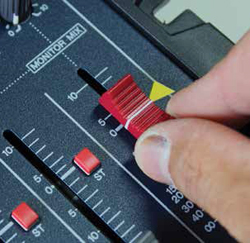
For Drummers
Drum subs are intended to provide drummers with the low end on stage that’s missing from their IEMs or wedges. It’s often not enough to simply place the sub near, or even on the drum riser.
For maximum effect, it must couple with the drummer’s backbone, not just his ears, so placing it on a road case to get it up in the air a couple feet can make a big difference. If it’s double-18 sub, even better – point one at his rear end and the other at his shoulder blades. And watch him drool.
For a fraction of the price of a hard-wired IEM, a miniature mixer can be purchased for drummers that allows them to not only take a feed from the monitor desk, but also hear the click and tracks during the show, just like in rehearsal. And it doesn’t need batteries.
Take The Call
Many shows and sets begin with a call on the walkie-talkie to alert the band’s crew. Most walkies have a 3.5-mm audio jack, and many consoles have a 2-track analog input that’s rarely used. (On an Avid Profile, it’s an RCA.) A short cable allows you to monitor the radio call to start the show while you have your ears in, and perhaps even put it in the band’s ears.
Use The Matrix
Every console has a matrix that goes largely unused in most stage monitor applications. Since any mix can be sent to a matrix, one use with in-ear monitors is to patch it to a spare IEM system, which allows any mix on the console to be quickly turned on at unity into a spare transmitter on a new frequency. It’s quicker and easier than re-patching XLRs at the back of a rack or desk.
But for the downstage center “money” mix? Just put it into two transmitters with a pair of “Y” cables.
Another powerful use of the matrix is to add in talkback microphones to the cue mix so the engineer can always hear them. Instead of routing the cue send directly to its IEM transmitter, return it to two inputs to the matrix and then add in the talkback or “shout” mics from FOH, the drummer, the guitar tech, etc. When you fader-down the cue, you’ll still hear anyone talking. To accomplish this on many consoles, patch out of the desk and back in again with a pair of short XLR cables.
Inputs for additional shout mics may be in short supply in the console’s stage rack, especially if you start eating up channels for double-patched inputs (instruments played by more than one musician) and FX returns. A compact mixer, like a Mackie 1402. can provide some economy by mixing all of the shout mics down to one or two inputs.
If the console’s stage rack is also full, there’s often a dedicated talkback input where they can all be returned, but now the engineer’s talkback mic might have to go in the mixer as well. This also might be where the walkie’s audio input lands.
Leaving shout mics open clouds both the cue mix and the tech (roadie) mix with ambient stage wash. It’s important to manage these mics, which can be done with a switched mic or a “proximity gate.” A momentary foot switch that can be operated even while holding a guitar is even better for musicians and roadies.
The Hot Shot from Radial Engineering takes a dynamic mic and sends it out a second XLR when its momentary footswitch is pressed. These can be used with hard-wired dynamic mics at singing positions or simply by backline techs off stage.
For those times you need to be able to use a wireless mic for talkback, Radial’s Remote Relay is an A-B switch that can be placed on the output of a wireless receiver, similarly controlled from anywhere on stage by one or more momentary footswitches, connected by an XLR.
As with the Hot Shot, pressing the momentary switch removes it from its vocal input channel and puts it into a talkback channel. By panning that talkback channel to one side, it lets the performer know that it’s no longer in the PA. (Thanks Peter Janis!)
Mark Frink is an independent author, editor, consultant and engineer who has mixed monitors for numerous top artists.


